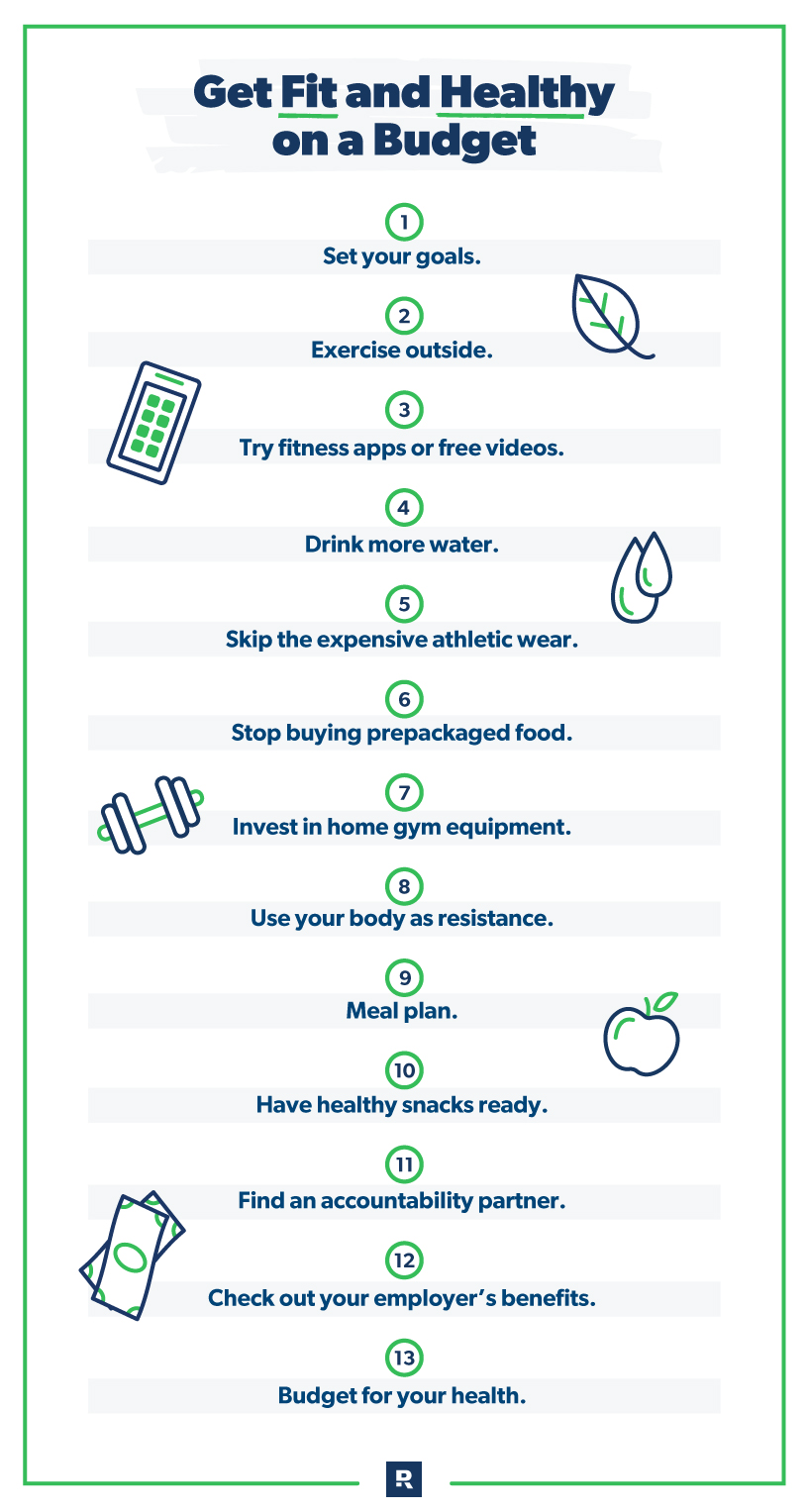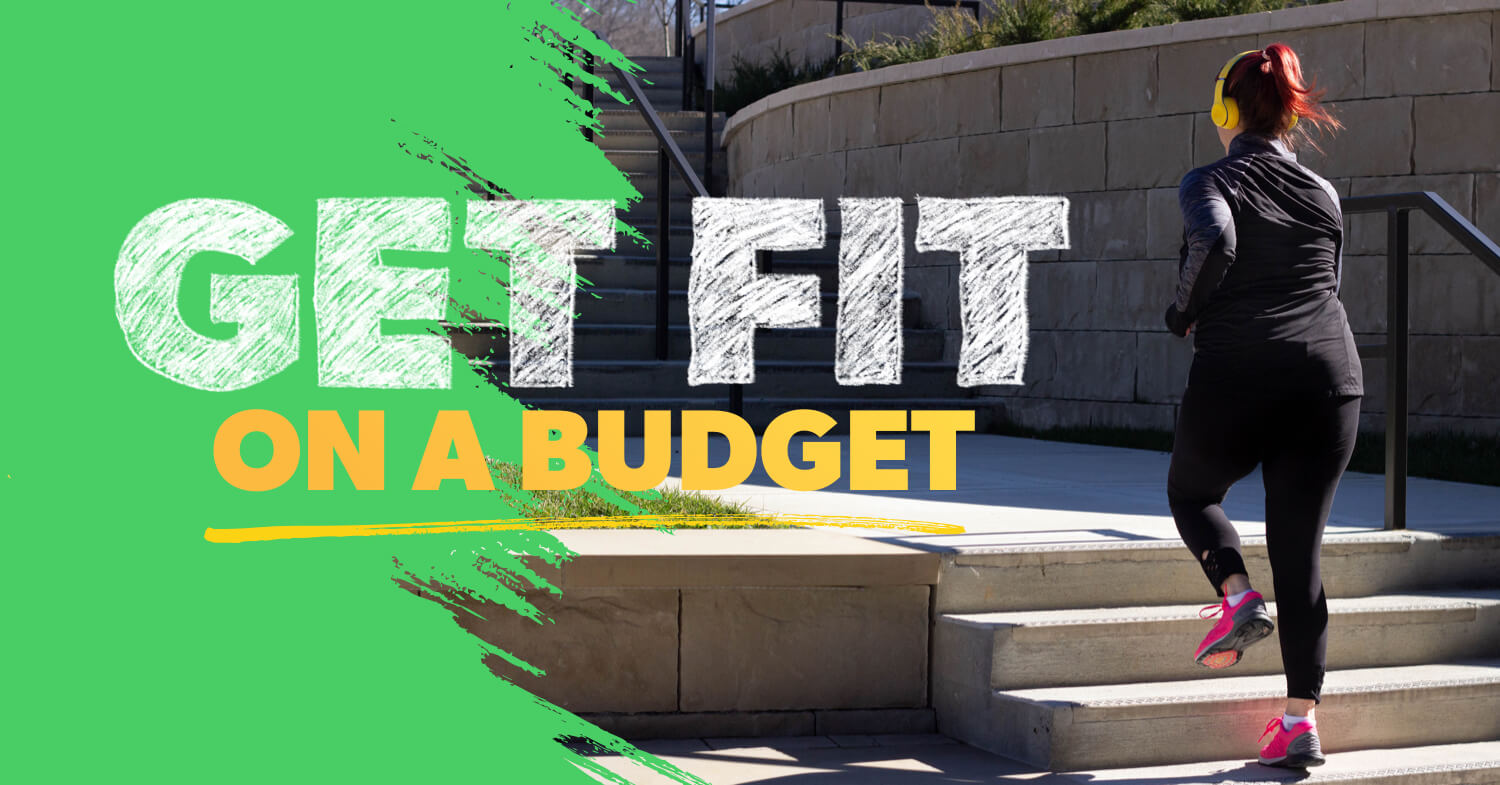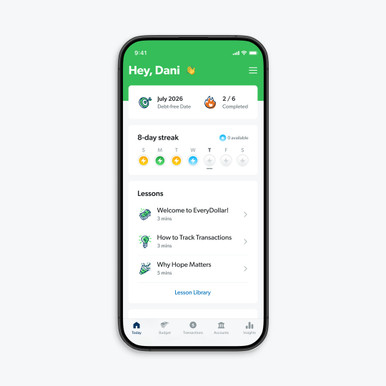When it comes to getting healthy, it’s easy to make excuses: But I don’t have the time. But I’m just too tired. But I just don’t have the willpower. But I’m on first-name basis with the donut guy. But I just can’t afford it!
Well, go ahead and scratch that last one off the list, because you 100% can get fit and healthy on a budget. And while you’re at it, cross off not having the willpower either. You can totally make the life changes you need to live the best life for your body and your budget. It’s time to stop bringing up those “buts” and start busting yours. Yeah, it’s work. But it’s worth it. So, try out one—or all 13—of these tips and get moving (literally).
13 Tips for Getting Fit and Healthy on a Budget
1. Set your goals.
Guess what? “I’m going to get healthy” isn’t a goal. It’s too vague. And “I’m going to run every day for two hours” when you’re crazy busy and have never run a day in your life isn’t doable. If you’re going to get healthy, you need to set measurable goals, and they need to be the perfect balance of empowering and realistic.
Get expert money advice to reach your money goals faster!
The next step to putting those health goals into action is writing them down and keeping them somewhere you can see them often. When you put goals into words and keep them in front of your face as both a reminder and a motivation, you’re bringing them to life. So, give them breath. Write them down.
2. Exercise outside.
Sometimes we believe we need fancy machines or hours in the gym to get in shape. But think about this—exercising outside is way more cost-effective than equipment, classes or memberships. Bonus: Fresh air is free.
So, take a hike (for real), go on a walk, or get running—outside. Nature’s gym is cheaper than man’s. Also, research shows spending time outside has benefits for both your body and mind. Plus, it helps boost your mood!1 So, strengthen your body and lower your anxiety and stress by exercising outside.
3. Try fitness apps or free videos.
You don’t have to pay for a pricey gym membership. There are plenty of free fitness apps and online videos. Even Instagram is full of free workout posts. You can test out different apps and programs to see what works best for your current lifestyle, workout preferences and athletic abilities. And don’t be afraid to push yourself. That’s how you grow.
Even some paid fitness apps offer a free trial. This is a fantastic way to try before you buy. Just be careful—if it’s not the app for you, don’t forget to cancel on time. But if it’s just what you wanted, make sure your budget is ready for it when the free trial ends!
4. Drink more water.
Drink. More. Water. It’s a healthy and cheap fitness tip—aka a win for your body and your budget. Sodas are expensive and loaded with sugar. You don’t need that junk slowing you down.
Here’s another idea: What if you started drinking that morning cup of joe black? No sugar or cream. You’ll save on the cost of those ingredients, and you’ll stop drinking your calories. That’s another healthy money and lifestyle win-win.
5. Skip the expensive athletic wear.
Turns out you can work out just as hard, burn just as many calories, and get just as fit in bargain-priced athletic wear. Okay, so we don’t have an extensive research study to back that statement—but trust us on this.
You do need good shoes (meaning they treat your feet well—not they’re worn by your fave athlete). And you do need clothing you can move in. But you don’t need expensive designer exercise clothing to work out.
6. Stop buying prepackaged food.
Processed, prepackaged foods aren’t good for you. But what we want to call out here are the prepackaged health foods. Listen: Food companies know they can charge more by slapping a health food buzzword on the packaging. “Keto-friendly” and “gluten-free” are eye-catching and exciting. Oh, how simple eating healthy will be with these prepackaged items! Right?
Maybe, but think about the cost. What if you made your own healthy snacks to save money? For example, some of those fruit and nut bars are literally two ingredients—like dates and cashews. Buy those items in bulk, pull out your food processor, and go to town making enough for the whole week at a fraction of the price.
Pro tip: If you’re wanting to buy fruit in bulk to make yourself daily smoothies, try frozen. Melissa R. points out in the Ramsey Baby Steps Community on Facebook, “Frozen fruits and veggies are cheaper, and you don't have to worry about them going bad before you can eat them.” Genius.
7. Invest in home gym equipment.
We’re not suggesting you go buy one of those complicated machines Chuck Norris swears by. Yes, those things boast that they can work every muscle in your body—even the ones you’ve never heard of and especially the ones you can’t pronounce. But they’re also expensive.
Instead, buy a sturdy yoga mat (which is great for all kinds of exercise) and some weights. Find used equipment super cheap from people who gave up or moved on to the next big thing in fitness. Don’t go crazy to start. You don’t want a bunch of stuff gathering dust and waiting on your next garage sale. If you decide you need more equipment later, just budget ahead to buy it.
8. Use your body as resistance.
When you exercise using “bodyweight resistance,” that means you’re literally using your own body, movement and gravity (thanks, Isaac Newton) instead of equipment! Think of arm circles, push-ups, planks, squats, lunges and even the worst of them all—burpees. (“Worst” only because it hurts so good.)
Do some Google searches to find examples, start moving, and get cut like Mount Rushmore.
9. Meal plan.
Eating healthy on a budget is possible. You just have to be intentional. And one way to be intentional is to meal plan. Meal planning is deciding up front—and on purpose—what you’ll eat for breakfast, lunch, dinner and snacks throughout the week. Plan out all those healthy meals. Make a list of ingredients you need.
Pro tip: Think about what you already have in your pantry, fridge and freezer first. Then, go to the grocery store and buy only what’s on your list to make those meals happen. Meal planning is good for the body and the budget.
10. Have healthy snacks ready.
When you’re shopping healthy, don’t forget to buy more than just meals. You need healthy snacks on hand for everyone in the house. Keep them at work too, so you don’t run to the snack machine every time your tummy growls. You’ll curb those junk food cravings, which can get expensive and are rarely a smart health decision.
11. Find an accountability partner.
There’s no shame in asking someone to help you keep your eye on the goal. Just the opposite—there’s incredible strength in asking for accountability. And an accountability partner costs you nothing. The only risks include tighter friendships and a higher likelihood of success. And those are risks we’re ready to take!
The best accountability partners are on the front lines with you. Find someone working toward a similar goal. You can vent your frustrations and share your wins together. You aren’t alone. So, don’t go it alone.
12. Check out your employer’s benefits.
Depending on where you work, you might have some awesome health benefits you can cash in on. Do you get discounts or reimbursements for a gym membership? Not all jobs have these kinds of perks, but you won’t know if you don’t ask!
13. Budget for your health.
You can have health goals and money goals. And you can knock out both at the same time. Just budget! The dumbbells, the smoothie ingredients, the yoga mat—put everything in your budget. It’s that kind of consistency and intentionality that will help you get healthy physically and financially.
And if you don’t already have one, we just so happen to have a free budgeting app called EveryDollar. What are you waiting for? Healthy habits await. Drink more water and start your free EveryDollar budget today!




